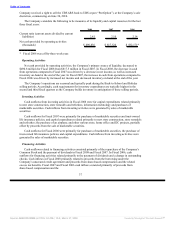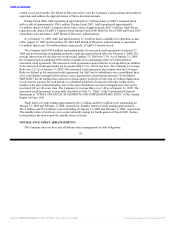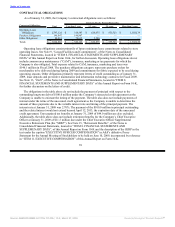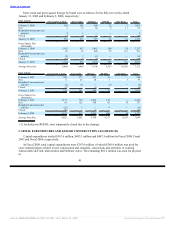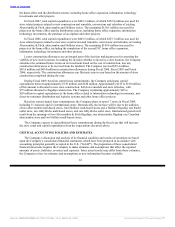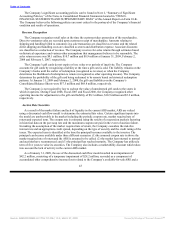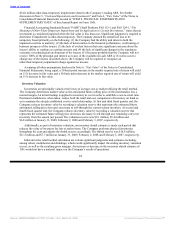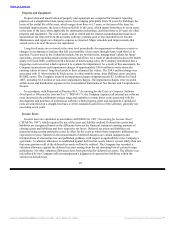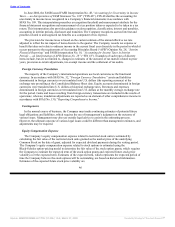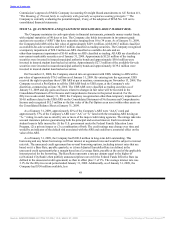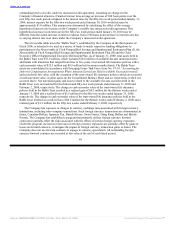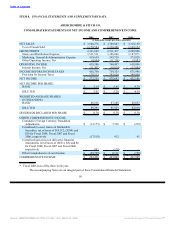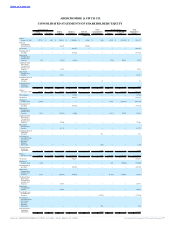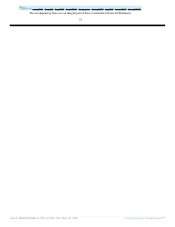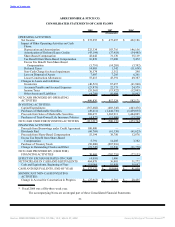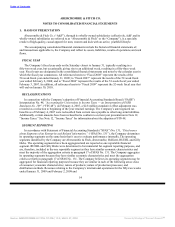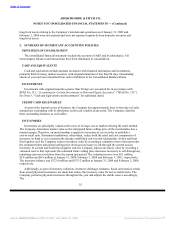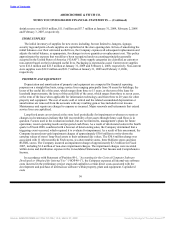Abercrombie & Fitch 2008 Annual Report Download - page 50
Download and view the complete annual report
Please find page 50 of the 2008 Abercrombie & Fitch annual report below. You can navigate through the pages in the report by either clicking on the pages listed below, or by using the keyword search tool below to find specific information within the annual report.
Table of Contents
based on the volatility of A&F’s Common Stock for the most recent historical period equal to the
expected term of the stock option. The Company calculates the historic volatility as the annualized
standard deviation of the differences in the natural logarithms of the weekly stock closing price, adjusted
for stock splits.
The fair value calculation under the Black-Scholes valuation model is particularly sensitive to
changes in the expected term and volatility assumptions. Increases in expected term or volatility will
result in a higher fair valuation of stock option and stock appreciation right grants. Assuming all other
assumptions disclosed in Note 4, “Share-Based Compensation” of the Notes to Consolidated Financial
Statements, located in “ITEM 8. FINANCIAL STATEMENTS AND SUPPLEMENTARY DATA” of
this Annual Report on Form 10-K being equal, a 10% increase in term will yield a 5% increase in the
Black-Scholes valuation for stock options and a 5% increase for stock appreciation rights, while a 10%
increase in volatility will yield a 9% increase in the Black-Scholes valuation or stock options and an 11%
increase for stock appreciation rights. The Company believes that changes in expected term and volatility
would not have a material effect on the Company’s results since the number of stock options granted
during the periods presented was not material.
RECENTLY ISSUED ACCOUNTING PRONOUNCEMENTS
In February 2008, the FASB issued FASB Staff Position (“FSP”) No. FAS 157-2 (“FSP 157-2”), that
partially delays the effective date of SFAS No. 157, “Fair Value Measurements” (“SFAS No. 157”), for
one year for non-financial assets and liabilities that are recognized or disclosed at fair value in the
financial statements on a non-recurring basis. Consequently, SFAS No. 157 was effective for the
Company on February 1, 2009 for non financial assets and liabilities that are recognized or disclosed at
fair value on a non-recurring basis. The Company is currently evaluating the potential impact of adopting
FSP 157-2 on the Company’s consolidated results of operations and consolidated financial condition.
In October 2008, the FASB issued FASB FSP 157-3, “Determining the Fair Value of a Financial
Asset When the Market for That Asset Is Not Active” (“FSP 157-3”), which clarifies the application of
SFAS No. 157 in a market that is not active and provides an example to illustrate key considerations in
determining the fair value of a financial asset when the market for that financial asset is not active.
FSP 157-3 was effective for and adopted by the Company on October 10, 2008, the date of issuance.
FSP 157-3 was consistent with the Company’s adoption of SFAS 157 and therefore did not have a
material impact on the Company’s Consolidated Financial Statements.
In March 2008, the FASB issued SFAS No. 161, “Disclosures about Derivative Instruments and
Hedging Activities — an amendment of FASB Statement No. 133” (“SFAS No. 161”), which changes the
disclosure requirements for derivative instruments and hedging activities. SFAS No. 161 requires
enhanced disclosures about (a) how and why an entity uses derivative instruments, (b) how derivative
instruments and related hedged items are accounted for under SFAS No. 133, “Accounting for Derivative
Instruments and Hedging Activities,” and its related interpretations, and (c) how derivative instruments
and related hedged items affect an entity’s financial position, financial performance and cash flows.
SFAS No. 161 was effective for the Company on February 1, 2009. The Company is currently evaluating
the potential impact, if any, of adopting SFAS No. 161 on disclosures in the Company’s consolidated
financial statements.
In May 2008, the FASB issued SFAS No. 162, “The Hierarchy of Generally Accepted Accounting
Principles” (“SFAS No. 162”). SFAS No. 162 identifies the sources of accounting principles and the
framework for selecting the principles to be used in the preparation of financial statements of
nongovernmental entities that are presented in conformity with generally accepted accounting principles
in the United States of America. SFAS No. 162 will be effective sixty days following the Securities and
Exchange
47
Source: ABERCROMBIE & FITCH CO /DE/, 10-K, March 27, 2009 Powered by Morningstar® Document Research℠


